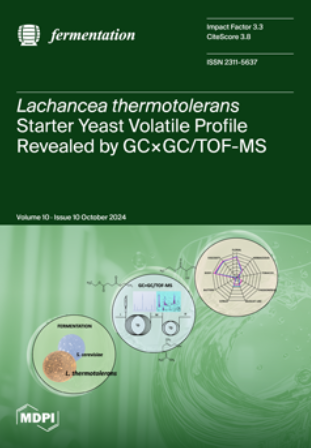嗜酸乳杆菌La5对2型糖尿病患者(T2D)和健康个体肠道微生物群组成和代谢的影响
IF 3.3
3区 农林科学
Q2 BIOTECHNOLOGY & APPLIED MICROBIOLOGY
引用次数: 0
摘要
2型糖尿病的特点是肠道微生态失调,这可能导致全身炎症。因此,益生菌的使用可能有助于实现微生物群的平衡,并改善血糖控制。本研究的目的是使用人类肠道微生物生态系统模拟器(SHIME®)验证嗜酸乳杆菌-La5对2型糖尿病成年人肠道微生物组的影响,并将其与健康受试者的微生物组进行比较。四组(对照组:降血糖;治疗组:T2D)在SHIME®中评估6周。结肠发酵7天和14天后,分析肠道微生物群(16S rRNA基因测序)和代谢产物(短链脂肪酸)。La5在治疗14天后改变了两组的微生物群组成,增加了拟杆菌门的丰度,减少了正常血糖中厚壁菌门的数量。用La5处理导致NormoGlycemic的微生物群落发生变化,类杆菌和Mitsuokella的丰度增加,无色杆菌和卡塔菌的数量减少,而T2D肠道微生物组富含Faecalibacterium,而类杆菌的数量减少。据报道,在NormoGlycemic中用La5治疗刺激的巨球藻属(Megasphaera spp.)会产生肠道代谢产物,并被认为有助于增加抗炎和免疫反应。另一方面,粪便杆菌可以调节肠道上皮,是微生物群中的主要丁酸产物。最后,本研究显示了La5治疗在增加T2D微生物群肠道稳态方面的积极和有希望的结果。本文章由计算机程序翻译,如有差异,请以英文原文为准。
Impact of Lactobacillus acidophilus—La5 on Composition and Metabolism of the Intestinal Microbiota of Type 2 Diabetics (T2D) and Healthy Individuals Using a Microbiome Model
Type 2 diabetes is characterized by dysbiosis in the gut, which may lead to systemic inflammation. Therefore, the use of probiotics may help to achieve a balanced microbiota and improve glycemic control. The aim of this study was to verify the impact of Lactobacillus acidophilus—La5 on the gut microbiome of type 2 diabetes adults using the Human Gut Microbial Ecosystem Simulator (SHIME®) and compare this to the microbiome of healthy subjects. Four groups (Control Group: NormoGlycemic; Treatment Group: T2D) were evaluated in SHIME® for 6 weeks. After 7 and 14 days of colonic fermentation, the intestinal microbiota (16S rRNA gene sequencing) and metabolites (short-chain fatty acids) were analyzed. La5 altered the composition of the microbiota after 14 days of treatment for both groups, by increasing the abundance of Bacteroidetes and a decrease in Firmicutes in the NormoGlycemic. Treatment with La5 resulted in a shift in the microbial community of NormoGlycemic with increased abundance of Bacteroides and Mitsuokella and a decrease in Achromobacter and Catabacter, whereas T2D gut microbiome was enriched with Faecalibacterium and reduced in Bacteroides. Megasphaera spp. stimulated with La5 treatment in NormoGlycemic has already been reported to produce intestinal metabolites and recognized to contribute to increased anti-inflammatory and immune responses. Faecalibacterium, on the other hand, can modulate the intestinal epithelium and be a major butyrate product in the microbiota. Finally, this study showed a positive and promising result of La5 treatment in increasing intestinal homeostasis in the microbiota of T2D.
求助全文
通过发布文献求助,成功后即可免费获取论文全文。
去求助
来源期刊

Fermentation-Basel
BIOTECHNOLOGY & APPLIED MICROBIOLOGY-
CiteScore
3.80
自引率
18.90%
发文量
594
审稿时长
7 weeks
期刊介绍:
Fermentation-Basel is an international open access journal published by MDPI, focusing on fermentation-related research, including new and emerging products, processes and technologies, such as biopharmaceuticals and biotech drugs. The journal enjoys a good reputation in the academic community and provides a high-impact forum for researchers in the field of bioengineering and applied microbiology.
 求助内容:
求助内容: 应助结果提醒方式:
应助结果提醒方式:


